Wildflowers of the Adirondacks:
Goldthread (Coptis trifolia)
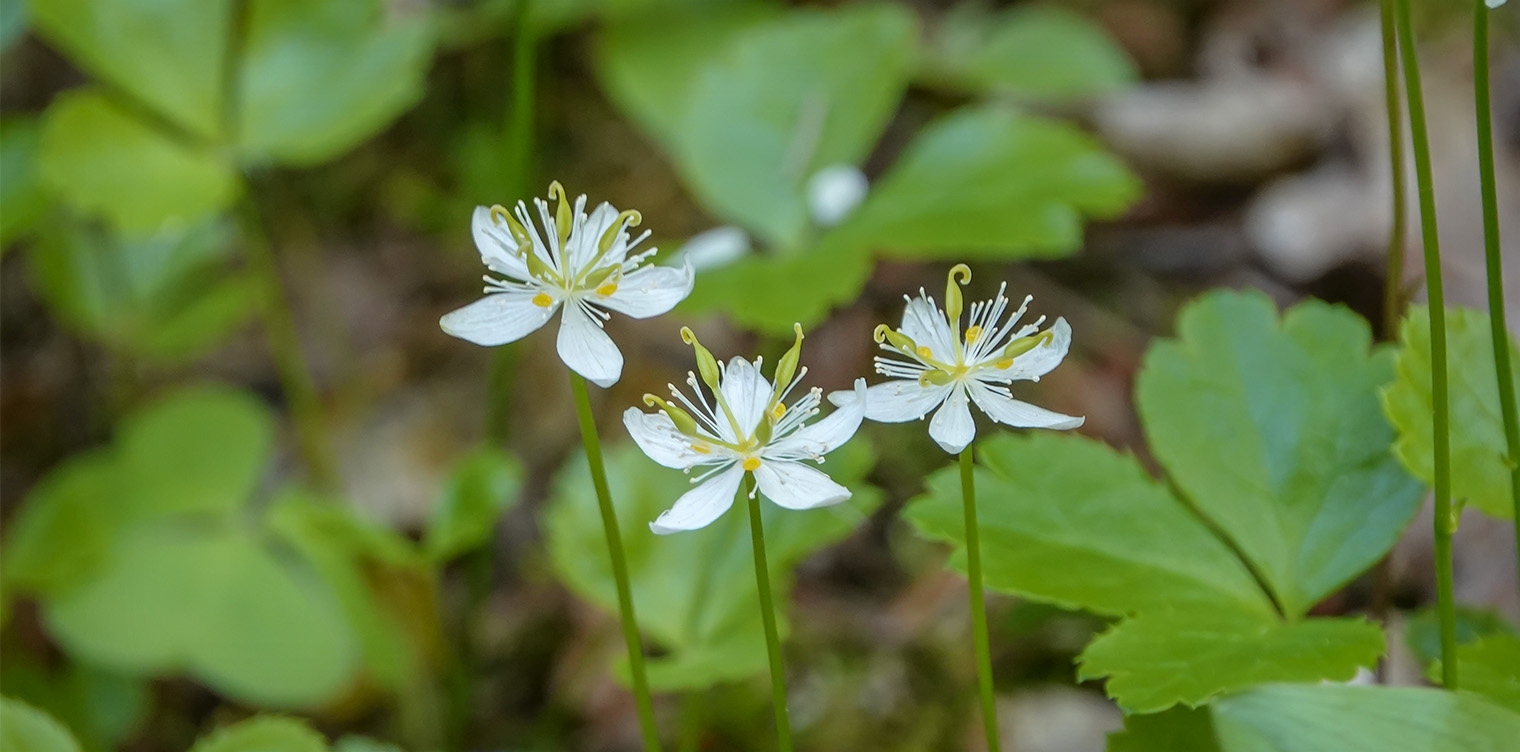
Goldthread (Coptis trifolia) is a low-growing native wildflower with glossy evergreen leaves. It produces small white flowers in May.
The common name refers to the yellow, thread-like underground roots. Other common names include Goldenthread, Goldenroot, Yellow Snakeroot, and Threeleaf Goldthread. Another common name, Canker-root, derives from the fact that early settlers and Indians used this plant to treat mouth sores.
The genus name Coptis comes from the Greek word meaning "to cut." This is a reference to the divided leaves. The word "trifolio" means "having three leaves," a reference to the number of leaflets. Goldthread is listed in some guide books as Coptis groenlandica – an earlier scientific name.
Identification of Goldthread
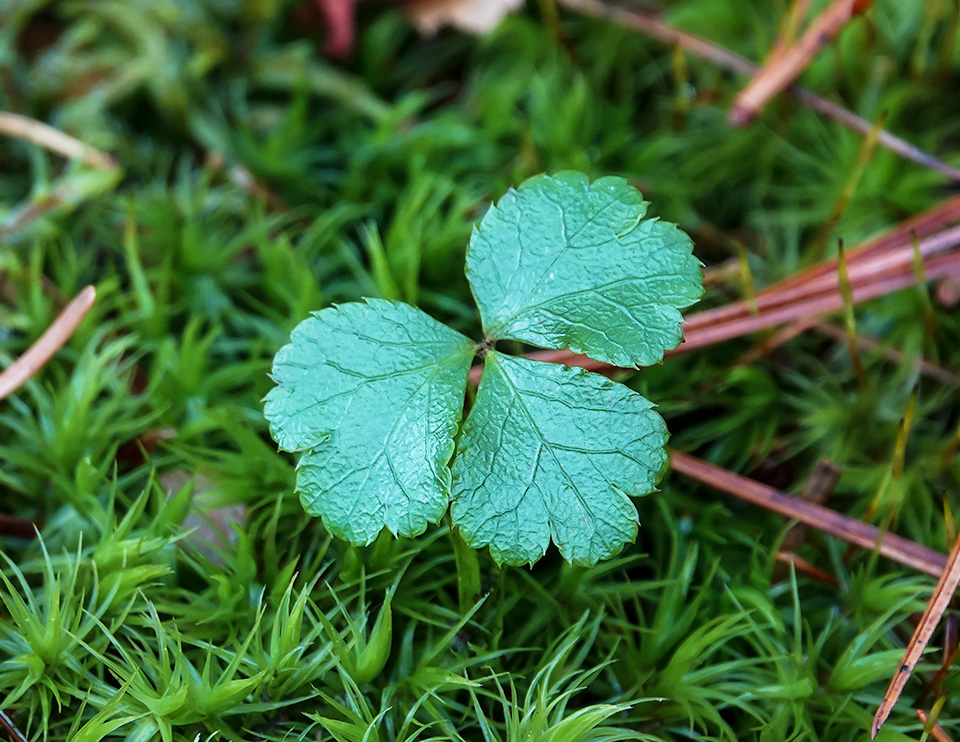
Goldthread is a low-growing evergreen, 3-6 inches tall. The long, slender roots which give the plant its name are a bright golden yellow or orange. The stems are slender and hairless.
The attractive, glossy evergreen leaves are 1-2" wide and appear at the end of a stem which is usually shorter than the flower stem.
- The leaves are compound
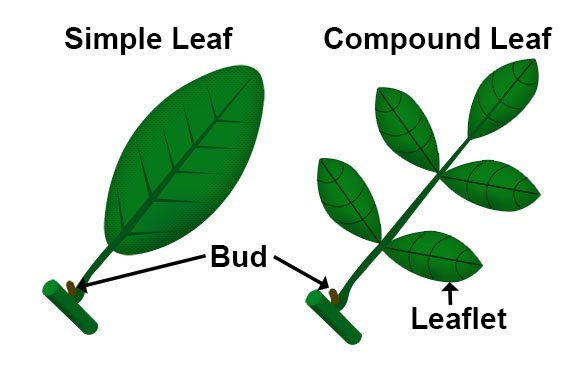 Compound Leaf: A leaf that is divided to the midrib, with distinct, expanded portions called leaflets., divided into three scalloped leaflets.
Compound Leaf: A leaf that is divided to the midrib, with distinct, expanded portions called leaflets., divided into three scalloped leaflets. - The leaflets are fan-shaped, with small teeth around the tip end.
- Goldthread's leaves uncoil every spring like a fern, as they replace the old evergreen leaves of the previous year.
Goldthread bears a solitary, small white flower on a long, slender, leafless stem. Each flower is ⅜ to ½ inch across and has four to seven petal-like sepals.gif) Sepals: The parts that look like little green leaves and cover the outside of a flower bud to protect the flower before it opens. and many white stamens
Sepals: The parts that look like little green leaves and cover the outside of a flower bud to protect the flower before it opens. and many white stamens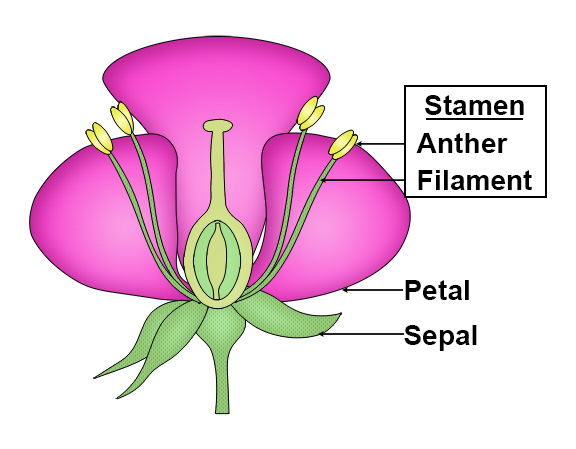 Stamen: The male part of the flower, made up of the filament and anther.. The bright green styles
Stamen: The male part of the flower, made up of the filament and anther.. The bright green styles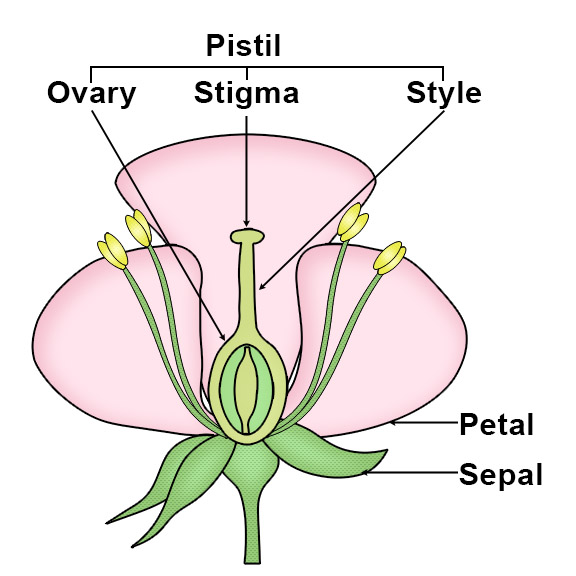 Style: The narrow, elongated part of the pistil between the ovary and the stigma. The style is part of the pistil (the female organs of a flower), which also consists of an ovary and a stigma. The style is the stalk that connects the stigma to the ovary. are curled at the tip. The golden yellow club-shaped petals
Style: The narrow, elongated part of the pistil between the ovary and the stigma. The style is part of the pistil (the female organs of a flower), which also consists of an ovary and a stigma. The style is the stalk that connects the stigma to the ovary. are curled at the tip. The golden yellow club-shaped petals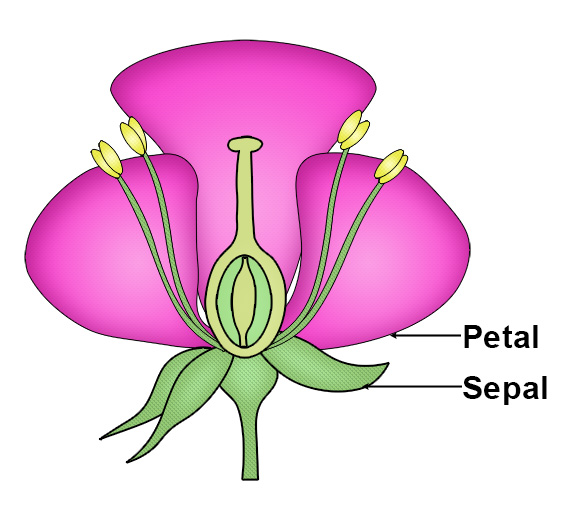 Petals: Modified leaves that surround the reproductive parts of flowers. Petals are often brightly colored or unusually shaped to attract pollinators. are shorter than the stamens and have a cup-shaped tip that holds nectar. Most plants have only one flowering stem.
Petals: Modified leaves that surround the reproductive parts of flowers. Petals are often brightly colored or unusually shaped to attract pollinators. are shorter than the stamens and have a cup-shaped tip that holds nectar. Most plants have only one flowering stem.
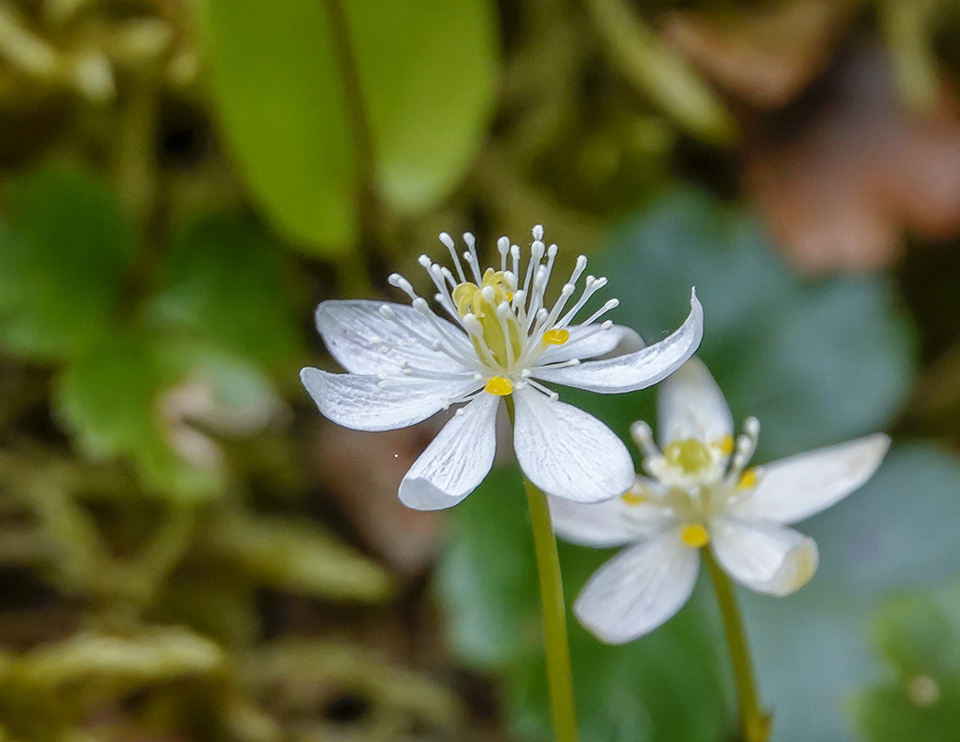
Goldthread usually begins blooming in the Adirondack Park in May. A tally of flowering dates for the upland Adirondack areas compiled by Michael Kudish, based on data collected from the early seventies to the early nineties, lists the earliest flower date as 12 May and the median date as 20 May. This is consistent with flowering dates in more recent years. In alpine zones on High Peaks summits in the Adirondacks, Goldthread blooms in early summer, from 14 to 30 June.
The flowers are followed by fruit. The fruit is an array of four to seven pods, each about 1/3 inch long. The capsule-like fruit changes from green to tan or light brown and splits open to expose the seeds.
Uses of Goldthread
Goldthread has been used for medicinal purposes. It reportedly was employed by native Americans and white settlers in North America to treat soreness in the mouth. The rhizome and roots are said to have antibacterial properties. They have also been used to heal sores of eyes, for thrush, as a tonic, and as a cure for alcoholism. The plant was also used as a gargle for sore throats and made into a tea for use as an eyewash.
The roots of this species have also been used to flavor beer. Some native American groups also used the roots as a yellow dye.
Wildlife Value of Goldthread
Goldthread has minimal wildlife value. It is said to be used as food in small amounts by Ruffed Grouse.
Distribution of Goldthread
Goldthread's range includes the northeastern United States and much of Canada. The plant is listed as endangered in Maryland and classified as sensitive in Washington.
This species occurs in almost all counties in New York State. It is found in all counties within the Adirondack Park Blue Line.
Habitat of Goldthread
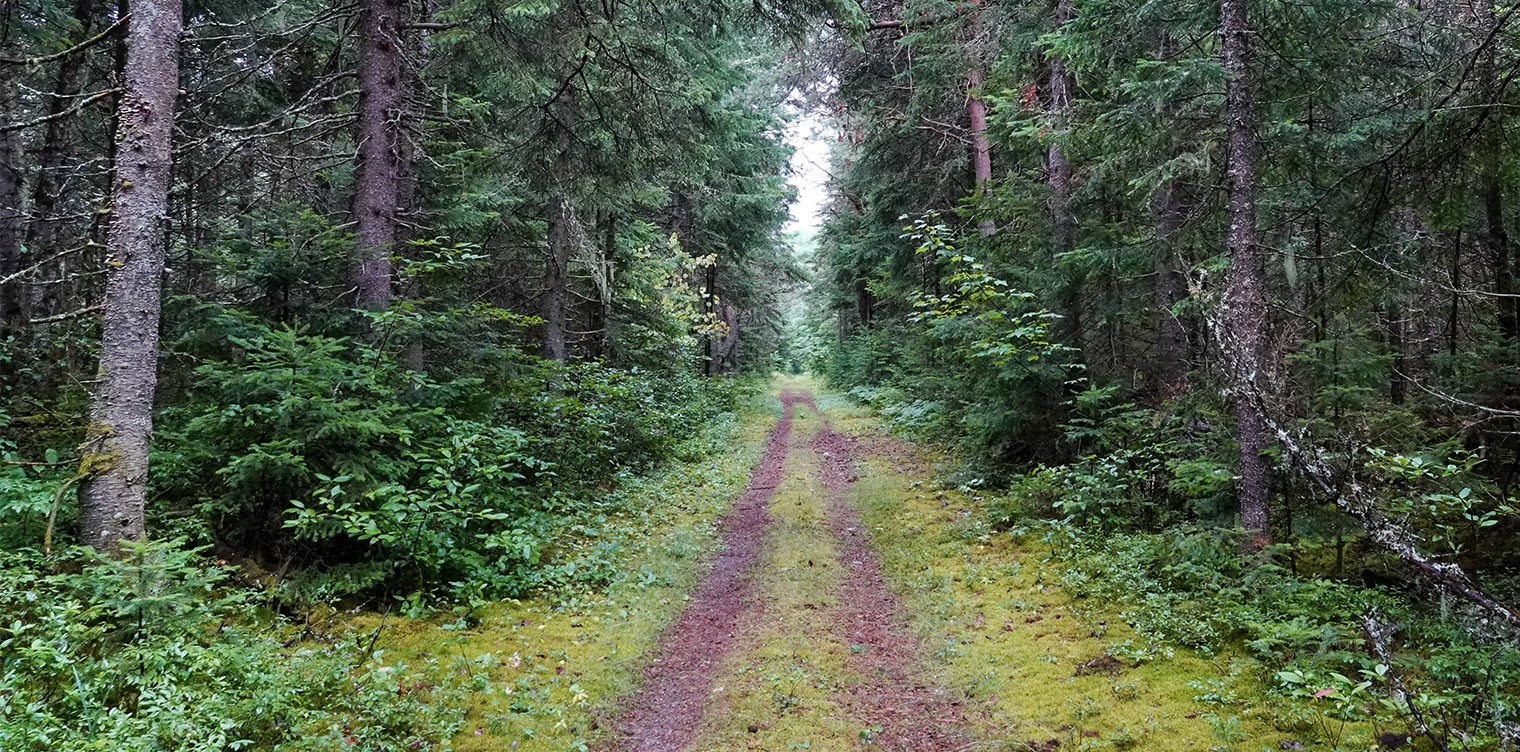
Goldthread is a shade-tolerant species. It is classified as a facultative wetland plant, meaning that it usually occurs in wetlands, but may occur in non-wetlands. It grows on moderately well-drained to poorly drained sites. It is not tolerant of disturbances and usually disappears or declines in abundance after logging. In the Forest Ecosystem Research and Demonstration Area (FERDA) at the Paul Smith's College VIC, an inventory of plants a decade after logging operations found that Goldthread declined in abundance in nearly all of the logged blocks.
Goldthread prefers shady areas at the base of conifers, often growing in beds of moss. It can also be found growing under hardwoods in mixed forests and under balsam in alpine zones. In the Adirondack Mountains, Goldthread is found in conifer, mixed forest, and wetland habitats, in a wide variety of ecological communities:
- Alpine Sliding Fen
- Balsam Flats
- Black Spruce-Tamarack Bog
- Hemlock-Hardwood Swamp
- Ice Cave Talus Community
- Mountain Fir Forest
- Mountain Spruce-Fir Forest
- Northern White Cedar Swamp
- Open Alpine Community
- Pine-Northern Hardwood Forest
- Red Maple-Tamarack Peat Swamp
- Rich Hemlock-Hardwood Peat Swamp
- Spruce Flats
- Spruce-Fir Swamp
- Spruce-Northern Hardwood Forest
Goldthread may be seen along many of the trails covered here, including the Heron Marsh Trail, Barnum Brook Trail, Boreal Life Trail, Woods & Waters Trail, Henry's Woods Loop Trail, Bloomingdale Bog Trail, and the Heart Lake Trail.
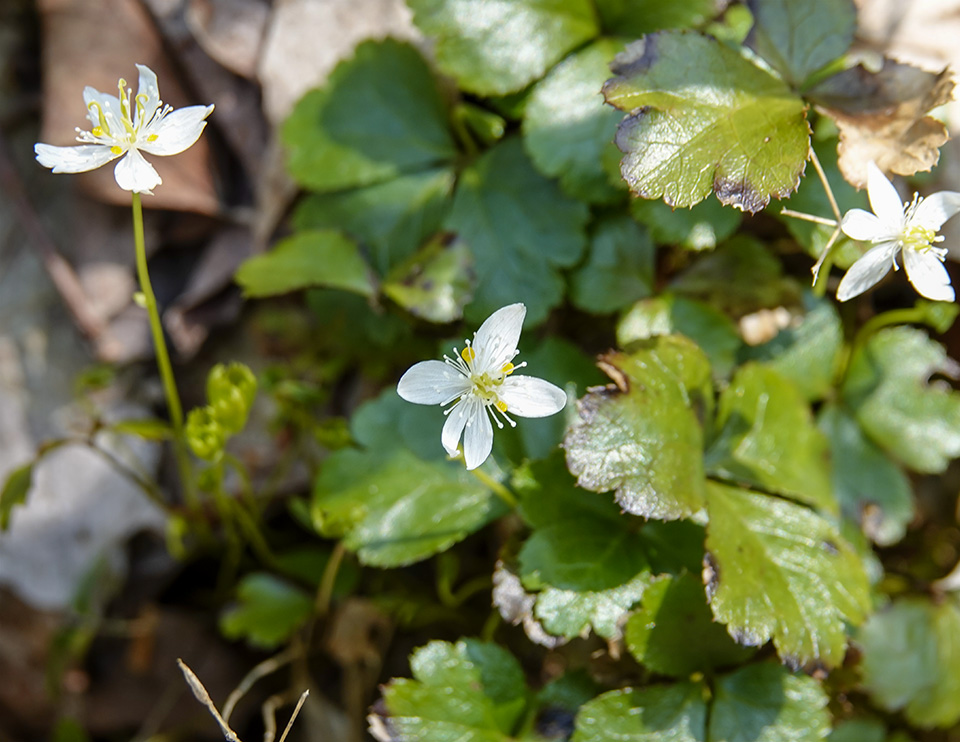
For instance, in trails that wind through spruce-northern hardwood forests, look for Goldthread growing alongside other plants that flourish in this habitat. The spruce-northern hardwood forest is a mixed forest and one of the most common forest types in the Adirondack region.
- The dominant trees in this habitat are Red Spruce, Sugar Maple, American Beech, Yellow Birch, and Red Maple, with scattered Balsam Fir.
- The most common subcanopy trees are Striped Maple and Mountain Maple.
- Characteristic shrubs include Hobblebush, Canada Yew, and American Fly Honeysuckle.
- Characteristic wildflowers, in addition to Goldthread, include Wild Sarsaparilla, Clintonia, Bunchberry, Canada Mayflower, Indian Cucumber-root, Rose Twisted Stalk, Starflower, and Common Wood Sorrel.
- Characteristic ferns include Hay-scented Fern, Spinulose Wood Fern, and Intermediate Wood Fern.
- Characteristic birds include White-throated Sparrow, Golden-crowned Kinglet, Pileated Woodpecker, and Canada Jay.
References
Michael Kudish. Adirondack Upland Flora: An Ecological Perspective (The Chauncy Press, 1992), pp. 25, 42, 108-109.
New York Flora Association. New York Flora Atlas. Gold-thread. Coptis trifolia (L.) Salisb. Retrieved 12 April 2017.
United States Department of Agriculture. The Plants Database. Threeleaf Goldthread. Coptis trifolia (L.) Salisb. Retrieved 12 April 2017.
United States Department of Agriculture. Fire Effects Information System (FEIS). Species Reviews. Coptis trifolia. Retrieved 12 April 2017.
Flora of North America. Coptis trifolia (Linnaeus) Salisbury. Retrieved 12 April 2017.
New York State. Department of Environmental Conservation. New York Natural Heritage Program. Ecological Communities of New York State. Second Edition (March 2014), pp. 71-72, 72, 73-74, 74-75, 76, 92-92, 105-105, 122, 123, 123-124, 124. Retrieved 17 October 2015.
New York Natural Heritage Program. 2022. Online Conservation Guide for Alpine Sliding Fen. Retrieved 29 March 2022.
New York Natural Heritage Program. 2022. Online Conservation Guide for Balsam Flats. Retrieved 29 March 2022.
New York Natural Heritage Program. 2022. Online Conservation Guide for Black Spruce-Tamarack Bog. Retrieved 29 March 2022.
New York Natural Heritage Program. 2022. Online Conservation Guide for Hemlock-Hardwood Swamp. Retrieved 29 March 2022.
New York Natural Heritage Program. 2022. Online Conservation Guide for Ice Cave Talus Community. Retrieved 29 March 2022.
New York Natural Heritage Program. 2022. Online Conservation Guide for Mountain Fir Forest. Retrieved 29 March 2022.
New York Natural Heritage Program. 2022. Online Conservation Guide for Mountain Spruce-Fir Forest. Retrieved 29 March 2022.
New York Natural Heritage Program. 2022. Online Conservation Guide for Northern White Cedar Swamp. Retrieved 29 March 2022.
New York Natural Heritage Program. 2022. Online Conservation Guide for Open Alpine Community. Retrieved 29 March 2022.
New York Natural Heritage Program. 2022. Online Conservation Guide for Pine-Northern Hardwood Forest. Retrieved 29 March 2022.
New York Natural Heritage Program. 2022. Online Conservation Guide for Red Maple-Tamarack Peat Swamp. Retrieved 29 March 2022.
New York Natural Heritage Program. 2022. Online Conservation Guide for Rich Hemlock-Hardwood Peat Swamp. Retrieved 29 March 2022.
New York Natural Heritage Program. 2022. Online Conservation Guide for Spruce Flats. Retrieved 29 March 2022.
New York Natural Heritage Program. 2022. Online Conservation Guide for Spruce-Fir Swamp. Retrieved 29 March 2022.
New York Natural Heritage Program. 2022. Online Conservation Guide for Spruce-Northern Hardwood Forest. Retrieved 29 March 2022.
New York State. Adirondack Park Agency. Preliminary List of Species Native Within the Adirondack Park Listed Alphabetically by Scientific Name and Sorted by Habit. Volume 1. Updated 10.23.2006, p. 19. Retrieved 26 January 2017.
Connecticut Botanical Society. Coptis trifolia (L.) Salisb. Retrieved 12 April 2017.
University of Wisconsin. Flora of Wisconsin. Coptis trifolia (L.) Salisb. Retrieved 12 April 2017.
Minnesota Wildflowers. Coptis trifolia (Three-leaf Goldthread). Retrieved 12 April 2017.
Lady Bird Johnson Wildflower Center. Coptis trifolia. Retrieved 12 April 2017.
Mark J. Twery, et al. Changes in Abundance of Vascular Plants under Varying Silvicultural Systems at the Forest Ecosystem Research and Demonstration Area, Paul Smiths, New York. USDA Forest Service. Research Note NRS-169. Retrieved 22 January 2017, p. 7.
Alexander C. Martin, Herbert S. Zim, and Arnold L. Nelson. American Wildlife & Plants. A Guide to Wildlife Food Habits (Dover Publications, 1951), pp. 94-96.
Plants for a Future. Coptis trifolia - (L.) Salisb. Retrieved 12 April 2017.
University of Michigan. Native American Ethnobotany. A Database of Foods, Drugs, Dyes and Fibers of Native American Peoples, Derived from Plants. Coptis trifolia (L.) Salisb. Retrieved 12 April 2017.
Ruth Schottman. Trailside Notes: A Naturalist's Companion to Adirondack Plants (Adirondack Mountain Club, 1998), pp. 43-45.
Anne McGrath. Wildflowers of the Adirondacks (EarthWords, 2000), p. 13.
Doug Ladd. North Woods Wildflowers (Falcon Publishing, 2001), p. 215.
Lawrence Newcomb. Newcomb's Wildflower Guide (Little Brown and Company, 1977), pp. 184-185.
Roger Tory Peterson and Margaret McKenny. A Field Guide to Wildflowers. Northeastern and North-central North America (Houghton Mifflin Company, 1968) pp. 30-31.
William K. Chapman, et al. Wildflowers of New York in Color (Syracuse University Press, 1998), pp. 10-11.
Ronald B. Davis. Bogs & Fens. A Guide to the Peatland Plants of the Northeastern United States and Adjacent Canada (University Press of New England, 2016), pp. 168-170.
Nancy G. Slack and Allison W. Bell. Adirondack Alpine Summits: An Ecological Field Guide (Adirondack Mountain Club, Inc., 2006), p. 26.
Charles H. Peck. Plants of North Elba. (Bulletin of the New York State Museum, Volume 6, Number 28, June 1899). Retrieved 22 February 2017.
